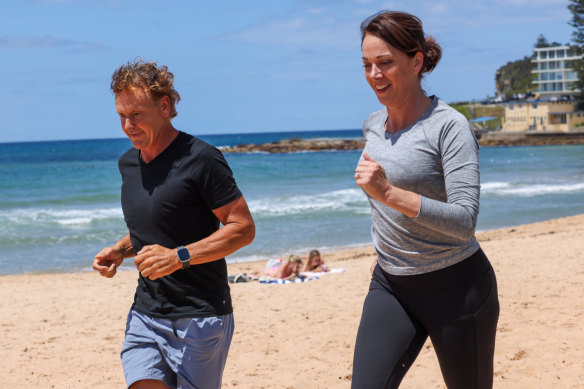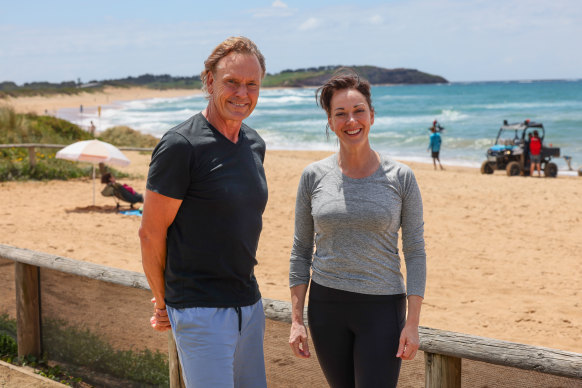Taking a 15-minute break to move around enhances productivity. But who has the time?
By Sarah Berry
We all know the benefits of exercise, but the reality of fitting it into our days is often a different story. As is the case for Dr Sophie Scamps, a GP, mother of three and the federal MP for Mackellar.
Trying to find time to interview Scamps is challenging as she is booked out from 6am to 10pm on the day I hope to speak with her. When we do connect, Scamps, a former world junior championship athletics gold medallist, says she’s “much less fit” than she was before being elected to office two and a half years ago.

MP Sophie Scamps and Fit for Office ambassador Guy Leech.Credit: Edwina Pickles
Today, Scamps struggles to make time to exercise despite waking at the “crack of dawn”, and knowing that being active makes her feel better, mentally and physically, helps her to manage the pressures of an “incredibly stressful” role and assists in managing menopause symptoms.
“I’m inclined to get up and start work straight away,” admits the 53-year-old. So how does she fit anything in?
After joining parliament in 2022, she was advised to buy a head torch, as the only time politicians typically get to move is in the dark. This is why Scamps, once ranked Australia’s top 800-metre runner, often walks to Parliament House before the sun rises.
On good days, she might fit in a yoga class, a surf or a walk. On the days that’s not possible, she walks – sometimes runs – the stairs of the House.
How often do we need to move?
New research involving 26,000 participants around the world, funded by ASICS, found we don’t need much movement during the day to significantly affect our mood, stress levels and even productivity.
Taking 15-minute movement breaks every two hours led to a 22.5 per cent increase in mental wellbeing scores, a 33.2 per cent boost in productivity and a 28.6 per cent improvement in focus.
When I ask lead author Dr Brendon Stubbs from King’s College London how realistic it is to get up every two hours for 15 minutes, he says we need to recognise these breaks as essential for optimal work performance.
“This isn’t just about ‘taking time away from work’, it’s about working smarter,” Stubbs says. “While many cite heavy workloads and deadlines as barriers, our research suggests that movement breaks actually enhance our ability to handle these pressures.
“Moving for just 15 minutes increases blood flow to areas of the brain involved in emotional processing and decision-making, helping us work more effectively.”
Who is fit for office?
In her desire to build regular exercise back into her life and show it’s possible to incorporate exercise into the busiest of lives, Scamps has signed up for the Fit For Office challenge.
She will join more than 30 federal MPs and senators in a three-week fitness challenge led by former ironman Guy Leech.

Former ironman Guy Leech will help Sophie Scamps find time for exercise in her busy schedule. Credit: Edwina Pickles
“We all get 168 hours in the week,” says Leech. “We need to prioritise exercise and set goals. It’s not impossible.”
He adds that waiting until after work is unrealistic for most people as life gets in the way. “But, at 6am or 6.30am, no one is going to set a meeting for you.”
The challenge by AUSactive, Australia’s peak body for the exercise and active health sector, will be launched on November 19 from Parliament House and aims to inspire Australians to move more.
Most Australian adults are insufficiently active and more than two in three are overweight or obese.
“The Fit For Office challenge is to get politicians involved themselves in physical activity and exercise,” AUSactive chief executive Barrie Elvish says. “It’s to provide positive role models for the community and to get them thinking about the need for a public health campaign encouraging all people to get outside and partake in physical activity and exercise.”
Elvish believes there is much the government could do to help us all be more active. This includes FBT exemptions for gym memberships, aged care packages that provide personal training, physical activity classes in early childhood centres and the workplace facilitation of ASICS findings.
Scamps adds she is pushing for more active transport options as well as ending junk food and gambling advertising.
When we move more and are supported to be healthy, the effects can be profound.
“What’s particularly exciting is that this isn’t about high-intensity exercise or complex interventions,” Stubbs says.
“It’s simply about breaking the cycle of prolonged sitting with intentional movement. It’s accessible, it’s achievable and, most importantly, it works. These 15 minutes aren’t just a break from work – they’re an investment in our mental clarity and productivity for the hours that follow.”
Make the most of your health, relationships, fitness and nutrition with our Live Well newsletter. Get it in your inbox every Monday.